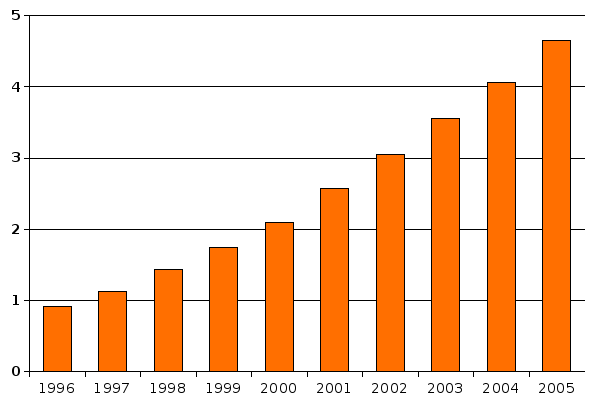Autism epidemiology and demographics: Difference between revisions
No edit summary |
No edit summary |
||
| Line 12: | Line 12: | ||
*{{cite journal|author=Fombonne E|title=The prevalence of autism|journal=JAMA|date=2003|volume=289|issue=1|pages=87–9|pmid=12503982}} | *{{cite journal|author=Fombonne E|title=The prevalence of autism|journal=JAMA|date=2003|volume=289|issue=1|pages=87–9|pmid=12503982}} | ||
*{{cite journal|author=Wing L, Potter D|title=The epidemiology of autistic spectrum disorders: is the prevalence rising?|journal=Ment Retard Dev Disabil Res Rev|volume=8|issue=3|year=2002|pages=151–61|pmid=12216059|doi=10.1002/mrdd.10029}}</ref> though as-yet-unidentified contributing environmental risk factors cannot be ruled out.<ref name=Rutter>{{cite journal |author= [[Professor Sir Michael Rutter|Rutter M]] |title= Incidence of autism spectrum disorders: changes over time and their meaning |journal= Acta Paediatr |volume=94 |issue=1 |date=2005 |pages=2–15 |pmid=15858952}}</ref> It is unknown whether autism's prevalence increased during the same period. An increase in prevalence would suggest directing more attention and funding toward changing environmental factors instead of continuing to focus on genetics. | *{{cite journal|author=Wing L, Potter D|title=The epidemiology of autistic spectrum disorders: is the prevalence rising?|journal=Ment Retard Dev Disabil Res Rev|volume=8|issue=3|year=2002|pages=151–61|pmid=12216059|doi=10.1002/mrdd.10029}}</ref> though as-yet-unidentified contributing environmental risk factors cannot be ruled out.<ref name=Rutter>{{cite journal |author= [[Professor Sir Michael Rutter|Rutter M]] |title= Incidence of autism spectrum disorders: changes over time and their meaning |journal= Acta Paediatr |volume=94 |issue=1 |date=2005 |pages=2–15 |pmid=15858952}}</ref> It is unknown whether autism's prevalence increased during the same period. An increase in prevalence would suggest directing more attention and funding toward changing environmental factors instead of continuing to focus on genetics. | ||
==References== | ==References== | ||
{{Reflist|2}} | {{Reflist|2}} | ||
[[Category:Mature chapter]] | |||
[[Category:Disease]] | |||
[[Category:Patient information]] | |||
[[Category:Psychiatry]] | |||
[[Category:Pediatrics]] | |||
[[Category:Neurology]] | |||
[[Category:Communication disorders]] | |||
[[Category:Neurological disorders]] | |||
[[Category:Autism]] | |||
{{WH}} | |||
{{WS}} | |||
Revision as of 21:09, 10 February 2013
|
Autism Microchapters |
|
Diagnosis |
|---|
|
Treatment |
|
Case Studies |
|
Autism epidemiology and demographics On the Web |
|
American Roentgen Ray Society Images of Autism epidemiology and demographics |
|
Risk calculators and risk factors for Autism epidemiology and demographics |
Editor-In-Chief: C. Michael Gibson, M.S., M.D. [1]
Overview
Most recent reviews estimate a prevalence of one to two cases per 1,000 people for autism, and about six per 1,000 for ASD, with ASD averaging a 4.3:1 male-to-female ratio. The number of people known to have autism has increased dramatically since the 1980s, at least partly due to changes in diagnostic practice; the question of whether actual prevalence has increased is unresolved.
Epidemiology

Most recent reviews tend to estimate a prevalence of 1–2 per 1,000 for autism and close to 6 per 1,000 for ASD;[1] because of inadequate data, these numbers may underestimate ASD's true prevalence.[2] PDD-NOS is the vast majority of ASD, Asperger's is about 0.3 per 1,000 and the remaining ASD forms are much rarer.[3] The number of reported cases of autism increased dramatically in the 1990s and early 2000s. This increase is largely attributable to changes in diagnostic practices, referral patterns, availability of services, age at diagnosis, and public awareness,[4] though as-yet-unidentified contributing environmental risk factors cannot be ruled out.[5] It is unknown whether autism's prevalence increased during the same period. An increase in prevalence would suggest directing more attention and funding toward changing environmental factors instead of continuing to focus on genetics.
References
- ↑ Newschaffer CJ, Croen LA, Daniels J; et al. (2007). "The epidemiology of autism spectrum disorders". Annu Rev Public Health. 28: 235–58. doi:10.1146/annurev.publhealth.28.021406.144007. PMID 17367287.
- ↑ Caronna EB, Milunsky JM, Tager-Flusberg H (2008). "Autism spectrum disorders: clinical and research frontiers". Arch Dis Child. 93 (6): 518–23. doi:10.1136/adc.2006.115337. PMID 18305076.
- ↑ Fombonne E (2005). "Epidemiology of autistic disorder and other pervasive developmental disorders". J Clin Psychiatry. 66 (Suppl 10): 3–8. PMID 16401144.
- ↑ Changes in diagnostic practices:
- ↑ Rutter M (2005). "Incidence of autism spectrum disorders: changes over time and their meaning". Acta Paediatr. 94 (1): 2–15. PMID 15858952.